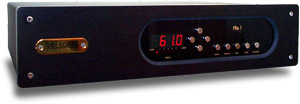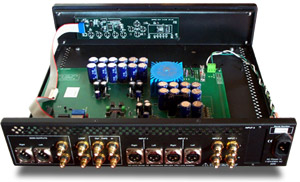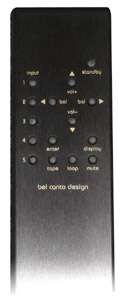![[SoundStage!]](../sslogo3.gif) Earmarked! Earmarked!Back Issue Article |
|
August 2001 Heretical Notions: Bel Canto Design PRe1 PreamplifierClass-T rabbi and former thermionic rabble-rouser John Stronczer of Bel Canto shared a story. After finalizing his digital eVo 200.2 amplifier and listening to it via the Bel Canto SEP1 tubed preamp, he noticed limitations in the preamp that had remained inaudible through use with his earlier tube amps. The digital amplifier pointed to tube-induced artifacts of harmonic distortion and tube noise that only materialized because of the 200.2's acutely magnified resolving power. Stronczer confided that he now wonders whether tubes really belong in low-level circuits at all. Today's solid-state successor to the tubed SEP1 is his private answer to this question. Surprising (and surprised) support for his notion came from two sources, another tube-amp designer and -- for the surprised part -- my own ears.
Audible proof To begin describing the sound of the Bel Canto PRe1, I'll summarize my findings with the Audiopax 3880 monoblocks. Their design brief attempts to emulate the peculiar micro-power triode aroma of 45 or 2A3 tubes while offering 28 watts of output power with standard KT-88 pentodes in a proprietary and very unconventional circuit. Now think of a complexly yet superbly balanced
upscale wine, say a bottle of Super Tuscan. Before you uncork it, water is simply the best
preceding fluid to quench your thirst. Regardless of how refined, another
"opening" wine will change your palate's chemistry. After experimenting with the 3880s and the PRe1, the Gill Audio Alana tubed preamp and Elise tube DAC, I began to think of the PRe1 as the non-flavor of superior non-carbonated table water. It allowed the Audiopax monos to unfold their finely balanced and very sophisticated flavor without being overshadowed or diluted. By extension, the tube preamp and tube DAC turned out to be their own fine wines. Inserting them into the electron stream caused a minor but audible congestion and change of gestalt. To appreciate how, leave our oenophile reference and think physiques instead. The sound of the 3880s with the PRe1 was lithe and sinewy, powerful yet fast, like ballet or tap dancers. Adding tubes turned more muscle-bound, heavier and slower, like a prizefighter. Low-level details were now blunted, probably due to increased noise floor or added colorations. The bass fattened and turned less agile and defined. Most importantly, something in the overall sonic fabric thickened. It became denser and tighter, less translucent or alive. It acquired a certain kind of texture that wasn't there before. As much as this defied whatever assumptions I may have held, I had to admit strike one against unmitigated thermionic self-righteousness. More tubes in the system clearly weren't better. I reflected then on something else Stronczer had said. His favorite Bel Canto tube product had been the SETi40 integrated amp. It used a tube output stage and solid-state preamp stage. The engineer in him added that modern op-amps now approach the noise floor of resistors -- in other words, they operate far below the quietest preamp tubes, even those whose pins are routinely and diligently cleaned to avoid corrosion. About the PRe1's architecture, Stronczer mentioned that it is internally single ended to maintain the circuit's low noise floor. Only at the I/O ports are signals converted to XLR, where he claims balanced advantage is greatest. The preamp's balanced output buffer is said to operate equally well into an XLR or RCA input, to prevent ground loops in both modes and further optimize the system's noise floor. Strike two The next evaluation would be against my Art Audio PX-25's optional attenuator. I'd compare going amp-direct with using the PRe1 in the circuit. Whenever the Bel Canto was to be used, the PX-25's attenuator would be opened all the way to essentially subtract it from the loop. You could proclaim this open attenuator a minor handicap. The ultimate scenario would have been to somehow physically remove it altogether for the Bel Canto's half of the playing cycle. Still, this was the closest I could come to a true bypass.
I honestly can't say for sure except that these changes may have occurred between either mode. In other words, the entire circuitry of the PRe1 (plus the complexity of the second Acoustic Zen Silver Reference interconnect with its two RCA jacks) amounted to no more sonic influence than one high-quality attenuator on its own. This would remain an odd and incomplete statement about the PRe1's ghost-like sonic non-existence if I didn't add what else it afforded: very suave remote control over 0.5dB volume increments; channel balance, input selection, mute and input-specific gain settings; automatic default to each input's last volume setting -- A/Bing between sources with different output voltages meant I could perform gain-matched comparisons with just two adjustments and then shuttle back and forth at random; slow ramp-up to last output setting for each newly selected input; momentary display brightening after each remote command, then return to standard intensity after five seconds; display on/off option; two single-ended and two balanced inputs; one tape loop; one single-ended throughput that bypasses the internal microprocessor-controlled Crystal 3310 attenuator chip (ideal for connecting a surround-sound processor); sets of RCA and XLR outputs. More dance partners We began with some popular assumptions about tube and solid-state-preamp/power-amp combinations. To investigate the other half of this equation, I had to return to the solid-state eVo 200.4 with both tube- and solid-state-preamp feeds. It's commonly believed that a tube preamp will provide a more fleshed-out harmonic spectrum and perhaps even transfer some of the tube-typical 3D-soundstaging effects on a partnering solid-state amp. In my last go-around with the eVo and Gill Alana, I had certainly noticed the harmonic effects and preferred it to the solid-state unit. However, I also had good reason to believe the PRe1 hadn't fully broken in then. It was now a few months later. That concern was toast. Strike three Insertion of the tube preamp caused the "musical molecules" to clump closer together for a thicker, darker and softer presentation. The PRe1's greater resolution accomplished what any higher-power microscope should accomplish -- resolve the space that separates those molecules to prove they're not really touching at all. This molecular spaciousness was airier, more diaphanous, suffused by light and visibility. It was also more incisive and crisper on transients that rose higher in the dynamic envelope and diminished with longer fade-trails. This difference wasn't subtle at all. What surprised me was my distinct preference for the PRe1/eVo combo. What had struck me as stark and relentless when first commented upon in the eVo 200.4 review now sounded more real, more alive, with no harmonic leanness or washout. This underscored yet again how real break-in is. In fact, Stronczer told me that Bel Canto actually measures it. For example, after four days of continuous use, the distortion spectrum of their DAC 1.1 shrinks radically. Greater context I've always considered preamplifiers unnecessary evils and configured my systems to not require any. This works if you're not a reviewer who worries about amplifiers arriving (as most do) without volume controls. My alter ego as columnist Silver Ears (or Shit Ears depending on how you misread my initials) now can't do without one. The Bel Canto Pre1 would fit the bill of my requirements perfectly. Its superior resolution isn't of the inhumanly fluorescent kind that makes your face in the mirror look very detailed, porous and starchy but also strangely alien and ugly. It's clarity is like that of water -- neutral, to allow the sound of source, amp and speaker to converge coherently and without imposing its own character. Its remote control is elegantly functional. The ability to both accept and pass balanced and single-ended signals avoids future connectivity problems. That it's so beautifully compatible with single-ended-triode amplifiers may not matter to those who think that breed fit for extinction, but it sure makes me smile like a bullfrog. Solid state for low-level, tubes for high-level signals is my new battle cry -- for now. Unfortunately for Bel Canto, I'm relatively ignorant about the greater preamp universe. I can't tell you from broad exposure where exactly within that grand puzzle the Pre1 belongs. I'll resort to comments from a storeowner friend for a vague fix. He found the earlier SEP1 to outperform the Audio Research Reference One, and the current PRe1 to be competitive with his beloved Mark Levinson No.380S. Read into that what you will. My one-on-one comparison with a $4000 tubed contender finds it to be exactly what I always thought the ideal preamp should be -- aside from source switcher and volume controller, really nothing. And that it is (not) with a vengeance! At $2495, the PRe1 is a must-audition for solid and fluid statesmen and -women who value musical honesty over colorations and truly appreciate (or better yet, demand) refined appearance and sophisticated remote convenience thrown into this excellent bargain. ...Srajan Ebaen
|
|
|
|
![[SoundStage!]](../sslogo3.gif) All Contents All ContentsCopyright © 2001 SoundStage! All Rights Reserved |
 Eduardo de Lima of Audiopax
had recently installed his new single-ended tube monoblocks in my system. He loved the
overall results and, without knowing the PRe1's identity, pronounced that "whatever
preamp you're using is truly phenomenal." After taking a closer look, he volunteered
that a superior solid-state preamplifier was in fact the very best match for a
well-designed SET amp. Of course, my solid-state-preamp/tube-power combination conflicted
with those popular notions that call a tube-preamp/solid-state-power-amp combo the
cat's meow. As a diehard tube fiend, I was soon to watch myself cheering the
"wrong" crowd.
Eduardo de Lima of Audiopax
had recently installed his new single-ended tube monoblocks in my system. He loved the
overall results and, without knowing the PRe1's identity, pronounced that "whatever
preamp you're using is truly phenomenal." After taking a closer look, he volunteered
that a superior solid-state preamplifier was in fact the very best match for a
well-designed SET amp. Of course, my solid-state-preamp/tube-power combination conflicted
with those popular notions that call a tube-preamp/solid-state-power-amp combo the
cat's meow. As a diehard tube fiend, I was soon to watch myself cheering the
"wrong" crowd. That will surely alter
and effectively spoil the Tuscan's delicate bouquet afterwards.
That will surely alter
and effectively spoil the Tuscan's delicate bouquet afterwards.  It was also the
closest I've come in a long time to counting the number of angels that fit on a pin's
point -- talk about subtleties! After an entire day of switching back and forth, the most
difference I thought I could determine was that perhaps the amp-direct route
bestowed a smidgen of added immediacy, with a marginal increase of soundstage
depth. The suspicion about immediacy was strongest directly at the very beginning of a
changeover track. Midway into it, I'd already second-guessed myself and questioned whether
I was imagining things. Was the PRe1's bass perhaps a mite more sharply outlined, a shade
crisper?
It was also the
closest I've come in a long time to counting the number of angels that fit on a pin's
point -- talk about subtleties! After an entire day of switching back and forth, the most
difference I thought I could determine was that perhaps the amp-direct route
bestowed a smidgen of added immediacy, with a marginal increase of soundstage
depth. The suspicion about immediacy was strongest directly at the very beginning of a
changeover track. Midway into it, I'd already second-guessed myself and questioned whether
I was imagining things. Was the PRe1's bass perhaps a mite more sharply outlined, a shade
crisper?